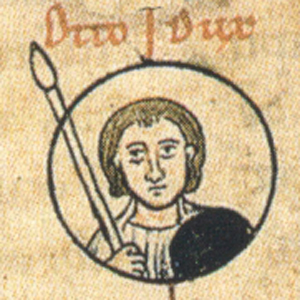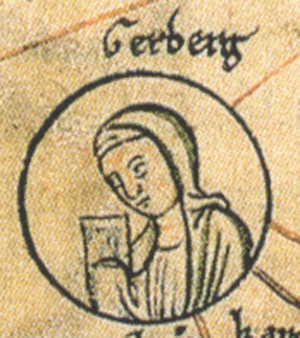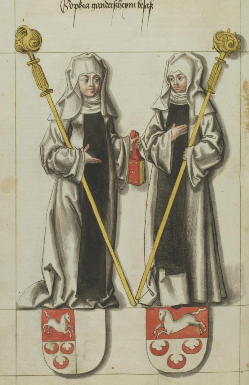Related Research Articles

Matilda of Ringelheim, also known as Saint Matilda, was a Saxon noblewoman who became queen of Germany. Her husband, Henry the Fowler, was the first king from the Ottonian dynasty, and their eldest son, Otto the Great, restored the Holy Roman Empire in 962. Matilda founded several spiritual institutions and women's convents. She was considered to be extremely pious, righteous and charitable. Matilda's two hagiographical biographies and The Deeds of the Saxons serve as authoritative sources about her life and work.

Hrotsvitha was a secular canoness who wrote drama and Christian poetry under the Ottonian dynasty. She was born in Bad Gandersheim to Saxon nobles and entered Gandersheim Abbey as a canoness. She is considered the first female writer from the Germanosphere, the first female historian, the first person since the Fall of the Roman Empire to write dramas in the Latin West, and the first German female poet.

Adelaide, Abbess of Vilich, also known as Adelheid, was the abbess of Vilich and also of St. Maria im Kapitol in Cologne; she was declared a saint post-mortem. After her death, she was remembered for the miracles that were ascribed to her. Her parents were Megingoz, count of Guelders, and Gerberga, who was a descendant of German king Henry the Fowler. They were also the founders of the convent at Vilich. The main source for her life is the hagiographical work Vita Adelheidis.

Otto, called the Illustrious by later authors, was a notable member of the Ottonian dynasty and Duke of Saxony from 880 until his death in 912. He played an important role in early medieval history of Germany during the 9th and 10th centuries, known for his military campaigns and diplomatic efforts.

Liudolf was a Carolingian office bearer and count in the Duchy of Saxony from about 844 until his death in 866. The ruling Liudolfing house, also known as the Ottonian dynasty, is named after him; he is its oldest verified member.

Gerberga of Saxony was the queen of France by marriage to Louis IV of France between 939 and 954. She ruled as regent during the minority of their son Lothair in 954–959.

Gandersheim Abbey is a former house of secular canonesses (Frauenstift) in the present town of Bad Gandersheim in Lower Saxony, Germany. It was founded in 852 by Count Liudolf of Saxony and his wife, Oda, progenitors of the Liudolfing or Ottonian dynasty, whose rich endowments ensured its stability and prosperity.
Saint Altfrid was a leading figure in Germany in the ninth century. A Benedictine monk, he became Bishop of Hildesheim, and founded Essen Abbey. He was also a close adviser to the East Frankish King Louis the German.
Matilda, also known as Mathilda and Mathilde, was a German regent, and the first Princess-Abbess of Quedlinburg. She served as regent of Germany for her brother during his absence in 967, and as regent during the minority of her nephew from 984.

Sophia I, a member of the royal Ottonian dynasty, was Abbess of Gandersheim from 1002, and from 1011 also Abbess of Essen. The daughter of Emperor Otto II and his consort Theophanu, she was an important kingmaker in medieval Germany.

Mathilde was Abbess of Essen Abbey from 973 to her death. She was one of the most important abbesses in the history of Essen. She was responsible for the abbey, for its buildings, its precious relics, liturgical vessels and manuscripts, its political contacts, and for commissioning translations and overseeing education. In the unreliable list of Essen Abbesses from 1672, she is listed as the second Abbess Mathilde and as a result, she is sometimes called "Mathilde II" to distinguish her from the earlier abbess of the same name, who is meant to have governed Essen Abbey from 907 to 910 but whose existence is disputed.

The Great Gandersheim Conflict was a conflict between the Archbishops of Mainz and the Bishops of Hildesheim concerning the jurisdiction over Gandersheim Abbey. It lasted from 987 to 1030, during the reign of the Ottonian emperors Otto III and Henry II as well as of their Salian successor Conrad II.

Gerberga II was the daughter of Henry I of Bavaria and his wife Judith, and a niece of Emperor Otto I. She was Abbess of Gandersheim from 956 to 1001 and personally instructed dramatist and poet Hrosvit of Gandersheim. Under Gerberga's rule, Gandersheim Abbey served as an Ottonian center of cultural, spiritual, and intellectual life.

The Deutsche Digitale Bibliothek or DDB is a virtual library in the German language which networks 30,000 cultural and research institutions and aims to make them freely accessible to the public using a common platform. A beta version of the portal with, according to its own information, about 5.6 million objects, went online on 28 November 2012. The first full version was launched on 31 March 2014. The aim is to integrate the DDB into Europeana at the European level.

Marie Elisabeth, Duchess of Mecklenburg was a princess of Mecklenburg-Schwerin. In 1712, following the unplanned late pregnancy and ensuing resignation of the formidable incumbent, Henriette Christine of Braunschweig-Wolfenbüttel, Marie Elisabeth became Princess Abbess of Gandersheim Abbey, but she died the next year.
The Vilich Abbey is a former monastery located in North Rhine-Westphalia. It is named after the canonized Adelaide of Vilich, who lived from 970 to 1015. After her death, a cult formed around her and the convent. The convent was terminated in 1804 due to secularization. It was destroyed during the Thirty Years´ war and rebuilt. The Franciscans took over the abbey as a hospital in 1865, followed by many different charitable institutions. The church was destroyed in World War II and once again restored, and is now used as a retirement home.

Christina, Duchess of Mecklenburg-Schwerin was a princess of Mecklenburg-Schwerin. Between 1681 and 1693 she served as the Abbess at Gandersheim. She was also a Princess of the Empire (Reichsfürstin).

Henriette Christine of Braunschweig-Wolfenbüttel was a German princess. Among the younger of her parents' many children, she was installed as Abbess of Gandersheim following the death in 1693 of abbess Christina of Mecklenburg, her cousin. She and her successor as abbess, Elisabeth Ernestine Antonie, were well connected and great patrons of the arts: in the judgement of certain historians they presided over something of a golden age at Gandersheim. In 1712 Abbess Henrietta Christine made her place in the history books secure by giving birth. This put an end to her tenure.

Elisabeth of Sachsen-Meiningen was a princess of Sachsen-Meiningen. Between 1713. Until her death in 1766, she had been the long-serving Abbess of the free imperial secular [quasi-monastic] foundation at Gandersheim.
Hathumoda was a Saxon noblewoman who became the first abbess of Gandersheim. Her family, the Liudolfings, founded the Gandersheim Abbey, and she was cloistered since childhood. After she died in an epidemic, there was an unsuccessful attempt to promote her as a saint.
References
- 1 2 3 4 "Die Verwandten der Ottonen und ihre Bedeutung in der Politik : Studien zur Familienpolitik und zur Genealogie des sächsischen Kaiserhauses - Deutsche Digitale Bibliothek". www.deutsche-digitale-bibliothek.de (in German). Retrieved 2024-01-06.
- ↑ A Companion to Hrotsvit of Gandersheim (fl. 960): Contextual and Interpretive Approaches. BRILL. 2012-10-12. ISBN 978-90-04-23439-0.